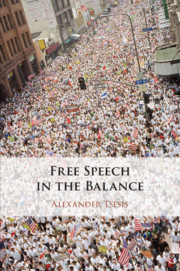Book contents
- Free Speech in the Balance
- Free Speech in the Balance
- Copyright page
- Dedication
- Contents
- Preface
- Acknowledgments
- Part I Theory
- Part II Application
- 5 US Formalism and EU Proportionality Alternative
- 6 Offense, Incitement, True Threats, and Hate Speech
- 7 Terrorist Incitement on the Internet
- 8 First Amendment on Campus
- 9 High Schooler Speech in the Age of the Internet
- 10 On the Campaign Trail
- Conclusion
- Notes
- Index
5 - US Formalism and EU Proportionality Alternative
from Part II - Application
Published online by Cambridge University Press: 06 November 2020
- Free Speech in the Balance
- Free Speech in the Balance
- Copyright page
- Dedication
- Contents
- Preface
- Acknowledgments
- Part I Theory
- Part II Application
- 5 US Formalism and EU Proportionality Alternative
- 6 Offense, Incitement, True Threats, and Hate Speech
- 7 Terrorist Incitement on the Internet
- 8 First Amendment on Campus
- 9 High Schooler Speech in the Age of the Internet
- 10 On the Campaign Trail
- Conclusion
- Notes
- Index
Summary
The first part of this book challenges the US categorical approach and elaborates a theory for judicial contextual analysis. The United States Supreme Court and scholars tend to be libertarian in opposition to such a proportionality approach to free speech. Scholars, like Professor James Weinstein, express concern that judicial balancing might lead to “ideological bias” and thereby reduce the “rigorous protection from content regulation.”305 Essential to free expression is the ability to maintain robust discussion and an openness to heterodox, nonconformist, and unpopular ideas.
- Type
- Chapter
- Information
- Free Speech in the Balance , pp. 77 - 82Publisher: Cambridge University PressPrint publication year: 2020

